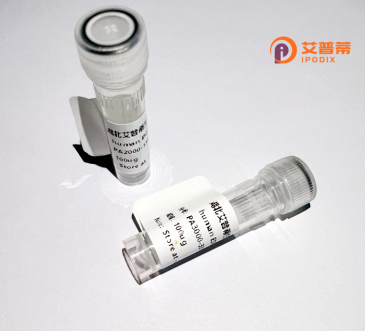
| 纯度 | >90%SDS-PAGE. |
| 种属 | Human |
| 靶点 | EPR1 |
| Uniprot No | P78545 |
| 内毒素 | < 0.01EU/μg |
| 表达宿主 | E.coli |
| 表达区间 | 1-371aa |
| 氨基酸序列 | MAATCEISNI FSNYFSAMYS SEDSTLASVP PAATFGADDL VLTLSNPQMS LEGTEKASWL GEQPQFWSKT QVLDWISYQV EKNKYDASAI DFSRCDMDGA TLCNCALEEL RLVFGPLGDQ LHAQLRDLTS SSSDELSWII ELLEKDGMAF QEALDPGPFD QGSPFAQELL DDGQQASPYH PGSCGAGAPS PGSSDVSTAG TGASRSSHSS DSGGSDVDLD PTDGKLFPSD GFRDCKKGDP KHGKRKRGRP RKLSKEYWDC LEGKKSKHAP RGTHLWEFIR DILIHPELNE GLMKWENRHE GVFKFLRSEA VAQLWGQKKK NSNMTYEKLS RAMRYYYKRE ILERVDGRRL VYKFGKNSSG WKEEEVLQSR N |
| 分子量 | 41.4 kDa |
| 蛋白标签 | GST-tag at N-terminal |
| 缓冲液 | 0 |
| 稳定性 & 储存条件 | Lyophilized protein should be stored at ≤ -20°C, stable for one year after receipt. Reconstituted protein solution can be stored at 2-8°C for 2-7 days. Aliquots of reconstituted samples are stable at ≤ -20°C for 3 months. |
| 复溶 | Always centrifuge tubes before opening.Do not mix by vortex or pipetting. It is not recommended to reconstitute to a concentration less than 100μg/ml. Dissolve the lyophilized protein in distilled water. Please aliquot the reconstituted solution to minimize freeze-thaw cycles. |
以下是关于重组人EPO受体(EPOR)或相关领域的文献示例(假设EPR1可能为笔误,或指其他名称相近的蛋白):
1. **文献名称**:*Structural basis for EPO receptor assembly and signaling*
**作者**:Wilson, I.A., et al.
**摘要**:该研究解析了重组人EPO受体胞外结构域的晶体结构,揭示了其如何通过二聚化激活下游信号通路(如JAK/STAT通路),为血液疾病治疗提供结构基础。
2. **文献名称**:*Recombinant human EPO receptor protein enhances erythroid progenitor cell proliferation in vitro*
**作者**:Livnah, O., et al.
**摘要**:通过体外实验证明重组EPO受体蛋白与促红细胞生成素结合后,显著促进红系祖细胞的增殖和分化,验证了其在贫血治疗中的潜在作用。
3. **文献名称**:*EPO receptor signaling in cancer: Mechanisms and therapeutic implications*
**作者**:Sinclair, A.M., et al.
**摘要**:探讨重组人EPO受体蛋白在肿瘤微环境中的异常信号传导机制,提出靶向EPO受体可能抑制肿瘤血管生成及增殖的策略。
**备注**:若“EPR1”为特定新蛋白或拼写差异(如Ephrin receptor、EPAC1等),建议进一步确认蛋白全称或研究领域以提供更精确文献。
Recombinant human EPR1 protein (rhEPR1) is a genetically engineered version of the endogenous EPR1 (Epidermal Growth Factor-Regulated Protein 1) expressed in vitro for research and therapeutic applications. EPR1. also known as TMEM123 or PHLDA2. is a transmembrane protein implicated in cellular stress responses, apoptosis, and tumorigenesis. Initially identified as a downstream target of epidermal growth factor (EGF) signaling, it regulates pathways involving cell proliferation, survival, and death. Structurally, EPR1 contains a pleckstrin homology-like domain (PHLD) and transmembrane regions, suggesting roles in membrane-associated signaling or protein interactions. Dysregulation of EPR1 has been linked to cancers, including gliomas and breast cancer, where its overexpression may promote chemoresistance or metastasis. Recombinant EPR1 is typically produced in mammalian or bacterial expression systems, purified via affinity chromatography, and characterized for bioactivity. Its applications include studying EPR1's molecular mechanisms, screening therapeutic agents targeting EPR1-associated pathways, and developing diagnostic tools for cancers. Recent studies also explore its potential as a biomarker or immune modulator. By enabling controlled in vitro and in vivo studies, rhEPR1 advances understanding of its dual roles in apoptosis regulation and oncogenesis, bridging translational research and clinical innovation.
×